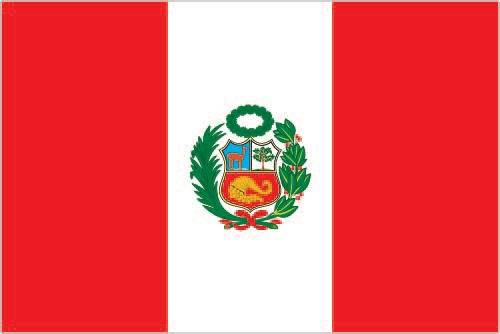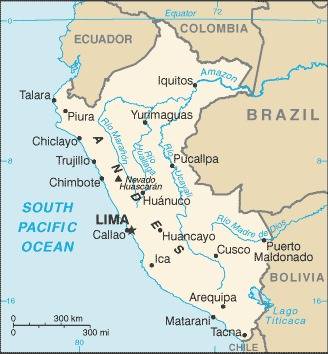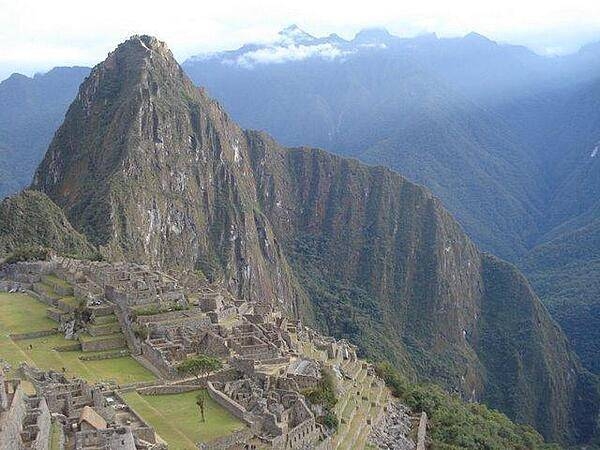29 Peru

Three equal, vertical bands of red (hoist side), white, and red with the coat of arms centered in the white band. The coat of arms features a shield bearing a vicuna (representing fauna), a cinchona tree (the source of quinine, signifying flora), and a yellow cornucopia spilling out coins (denoting mineral wealth). Red recalls blood shed for independence, white symbolizes peace.
Flag courtesy of the CIA World Factbook

Map courtesy of CIA World Factbook

A section of housing is seen in front of Machu Picchu’s Sacred Plaza, with the Intiwatana (Hitching Post of the Sun) above the plaza and the Western Urban Section to its right, where llamas roam.
Photo courtesy of the CIA World Factbook
Government
According to Britannica, Peru’s political history has been punctuated by numerous military coups and changes of constitution. The 1993 Peruvian constitution, which has since been amended several times, decrees a government headed by a president who is popularly elected to a five-year term and serves as chief of state and head of government. The president can be reelected but is prohibited from serving consecutive terms. The president appoints and presides over the Council of Ministers (Cabinet) and is assisted by the president of the Council of Ministers (in effect, the prime minister, who is also appointed by the president) as well as by two popularly elected vice presidents. Legislative power is vested in the unicameral Congress of the Republic, whose members are popularly elected to five-year terms.
For administrative purposes, the country is divided into 25 regions, which are further divided into departments, provinces, and districts. The regional level of government encompasses regions and departments; provinces, districts, and smaller population centers constitute the levels of local government.
The judiciary comprises the Supreme Court and lower courts and tribunals. The Supreme Court has nationwide jurisdiction and hears appeals from lower-court decisions; it also investigates the conduct of lower-court judges. All Supreme Court judges and some judges of lower courts are appointed by the National Council of the Magistracy. A Constitutional Court exists to review any challenges concerning the constitutionality of laws and acts of government. Members of the Constitutional Court are elected by Congress and serve five-year terms.
General Directorate of Civil Aviation
With regulatory technical authority at the national level exercised by the General Directorate of Civil Aviation of Peru, it is responsible for regulating, monitoring, supervising, sanctioning, as well as developing strategies to ensure that civil aviation activities and civil air navigation achieve a level of security. acceptable operational.
Airspace
SkyVector – Google Maps – ADS-B Exchange
ICAO countries publish an Aeronautical Information Publication (AIP). This document is divided into three parts: General (GEN), En Route (ENR) and Aerodromes (AD). ENR 1.4 details the types of airspace classes they chose to adopt from classes A through G.
The Peruvian Aeronautical Information Publication (AIP PERU) is issued/published by the Corporacion Peruana de Aeropuertos y Aviación Comercial S.A (CORPAC S.A.) under express responsibility, delegated by the Dirección General de Aeronáutica Civil (DGAC).
Peru AIP – requires user name and password
Drone Regulations
RAP 119 – Aerial Work – 2022 – Peruvian Aeronautical Regulation (RAP) 119 “Certification of Operators of Air Services and Aerial Works” NE – Amendment 2, Revision 002.
RPAS page – Registry of Remotely Piloted Aircraft Systems – RPAS Companies authorized in Peru.
Everything you need to know to operate a drone – 2022 – requirements to register this equipment and request the respective permits from the MTC.
Know the requirements to fly a drone in Peru – 2019 – Users of remotely piloted aircraft must meet three important requirements.
Permits needed to fly a drone in Peru – 2022 – These are the procedures you must complete to obtain authorization from the MTC.
Learn what authorizations you need to obtain to operate a drone.
MTC: These are the requirements for operating a drone in Peru.
Advanced Air Mobility (AAM) Regulations & Policies
None found by the author.
However, should you, the reader, happen to stumble across something to the contrary, please email the author at FISHE5CA@erau.edu and you may be mentioned in the ACKNOWLEDGEMENTS section of this book by way of thanks for contributing to this free eBook!
Advanced Air Mobility (AAM) News
2025
Video courtesy of Advanced Air Mobility Institute from the July 2025 Global AAM Forum.
2025
Video courtesy of Advanced Air Mobility Institute from the January 2025 Global AAM Forum. Complete session for Day 1 of this Forum is available on the Advanced Air Mobility Institute YouTube Channel
Short Essay Questions
Scenario-Based Question
You have been hired by a Drone Startup Company. Your boss has immediately assigned this job to you.
They need you to prepare a one-page memo detailing the legalities of using a drone at the archaeological site of Machu Picchu, pictured above.
They need you to mention any national laws and local ordinances.
They specifically want to know what airspace (insert pictures) you will be operating in and whether or not you need an airspace authorization.
Does it matter whether or not you are a citizen of the country?
Lastly, there is a bonus for you if, as you scroll through this chapter, you find any typos or broken links!
Short Essay Questions
- What are the drone categories?
- How is registration addressed?
- How is remote ID addressed?
- What are the model aircraft rules?
- What are the commercial drone rules?
- Are there waivers or exemptions to the rules? If so, for what?
- Would you share a link to an interactive airspace map?
- How is BVLOS addressed?
- How can you fly drones at night?
- How can you fly drones over people?
- Where do you find drone NOTAMs?
- What are the rules for drone maintenance?
- What are the rules for an SMS program?
- What are some unique rules not mentioned above?
- What are the C-UAS rules?
- What are the AAM rules?

